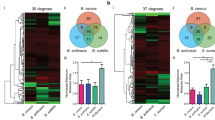Abstract
The growth yields of 10 strains ofBacteroides fragilis isolated from a variety of clinical sites were determined in (a) basal medium, (b) basal medium plus heme, and (c) basal medium plus heme and menadione. The molar growth yield values, expressed as a function of glucose (YG) and ATP produced (YATP) for 24 h and 48 h were used for a comparison of different strains. Considerable variation occurred among strains, but in general only the results from 24-h grown cells were reproducible. After this period, the microscopic appearance of cells changed dramatically from well-formed, intact cells to large collections of extracellular vesicles and lysed cells. All strains were stimulated by heme, but marked differences occurred among strains. The addition of heme and menadione to the basal medium increased the YG values of some strains, whereas others were unaffected. Heme-cultured cells produced acetate, propionate, and succinate as major metabolic end products and possessed cytochrome b, menaquinone-10, and fumarate reductase activity. Strain NCTC 9343 grown without added heme by continuous culture or batch culture produced cells that were morphologically and biochemically similar. Under both conditions these cells lacked cytochromes, menaquinones, and fumarate reductase activity, but produced high levels of lactate and fumarate together with lower levels of acetate, propionate, and succinate.
Similar content being viewed by others
Literature Cited
Bauchop T, Elsden SR (1960) The growth of microorganisms in relation to their energy supply. J Gen Microbiol 23:457–469
Connolly JC, McLean C, Tabaqchali S (1984) The effect of capsular polysaccharide and lipopolysaccharide ofBacteroides fragilis on polymorph function and serum killing. J Med Microbiol 17:1259–1271
Dowell VR, Hawkins TM (1974) Laboratory methods in anaerobic bacteriology. CDC Publications No. 77-8272, Centers for Disease Control, Atlanta, Georgia.
Duerden BI, Collee JG, Brown R, Deacon AG, Holbrook WP (1980) A scheme for the identification of clinical isolates of gram-negative anaerobic bacilli by conventional bacteriological tests. J Med Microbiol 13:231–245
Finegold SM, George WL, Mulligan ME (1985) Anaerobic infections. Part 1. Disease-a-month XXXI (10):17–69
Gorbach SL, Bartlett JG (1974) Anaerobic infections. N Engl J Med 290:1237–1245
Harris MA, Reddy CA (1977) Hydrogenase activity and the H −2 fumarate electron transport system inBacteroides fragilis. J Bacteriol 131:922–928
Holdeman LV, Cato EP, Moore WEC (1977) Anaerobe laboratory manual, 4th ed. Blacksburg, Virginia: Virginia Polytechnic Institute and State University.
Jones GR, Gemmell CG (1986) Effects ofBacteroides asaccharolyticus cells andB. fragilis surface components on serum opsonisation and phagocytosis. J Med Microbiol 22:225–229
Kasper DL, Onderdonk AB, Polk BF, Bartlett JG (1979) Surface antigens as virulence factors in infection withBacteroides fragilis. Rev Infect Dis 133:79–87
Knivett VO, Shah HN, McKee AS, Hardie JM (1983) Numerical taxonomy of some nonsaccharolytic and saccharolyticBacteroides. J Appl Bacteriol 55:71–80
Lev M, Keudell KC, Milford AF (1971) Succinate as a growth factor forBacteroides melaninogenicus. J Bacteriol 108:175–178
Macy J, Probst I, Gottschalk G (1975) Evidence for cytochrome involvement in fumarate reduction and adenosine 5′-triphosphate synthesis byBacteroides fragilis grown in the presence of hemin. J Bacteriol 123:436–442
McKee AS, McDermid AS, Baskerville A, Dowsett AB, Ellwood DC, Marsh PD (1986) Effect of hemin on the physiology and virulence ofBacteroides gingivalis W50. Infect Immun 52:349–355
Mountfort DO, Roberton AM (1977) The role of menaquinone and b-type cytochrome in anaerobic reduction of fumarate by NADH in membrane preparations fromBacteroides ruminicola strain B, J Gen Microbiol 100:309–317
Muller HE, Werner H (1970) Die Neuraminidase als pathogenetischer Faktor bei einem durchBacteroides fragilis bedingten Abscess. Med Microbiol Immunol 156:98–106
Onderdonk AB, Kasper DL, Cisneros RL, Bartlett JG (1977) The capsular polysaccharide ofBacteroides fragilis as a virulence factor: comparison of the pathogenic potential of encapsulated and unencapsulated strains. J Infect Dis 136:82–89
Onderdonk AB, Moon NE, Kasper DL, Bartlett JG (1978) Adherence ofBacteroides fragilis in vivo. Infect Immun 19:1083–1087
Polk BF, Kasper DL (1977)Bacteroides fragilis subspecies in clinical isolates. Ann Intern Med 86:569–571
Quinto G, Sebald S (1964) Identification of three hemin requiringBacteroides strains. Am J Med Technol 30:378–384
Rizza V, Sinclair PR, White DC, Courant PR (1968) Electron transport of the protoheme requiring anaerobeBacteroides melaninogenicus. J Bacteriol 96:665–671
Rudek W, Hague RU (1976) Extracellular enzymes of the genusBacteroides. J Clin Microbiol 4:458–460
Shah HN, Collins MD (1980) Fatty acid and isoprenoid quinone composition in the classification ofBacteroides melaninogenicus and related taxa. J Appl Bacteriol 48:75–87
Shah HN, Williams RAD (1987) Catabolism of aspartate and asparagine byBacteroides intermedius andBacteroides gingivalis. Curr Microbiol 15:313–318
Shah HN, Williams RAD, Bowden GH, Hardie JM (1976) Comparison of the biochemical properties ofBacteroides melaninogenicus from human dental plaque and other sites. J Appl Bacteriol 48:75–87
Shah HN, Bonnet R, Mateen B, Williams RAD (1979) The porphyrin pigmentation of subspecies ofBacteroides melaninogenicus. Biochem J 180:45–50
Shah HN, Elhag KM, Al-Jalili TAR, Mundegar ZR (1987) Glucose-6-phosphate dehydrogenase and malate dehydrogenase enzyme electrophoretic patterns amongst strains ofBacteroides fragilis. J Gen Microbiol 133:1975–1981
Shah HN, Elhag KM, Al-Jalili TAR, Gharbia SE, Pazhoor AA, Alex A (1987) Changes in metabolism and virulence ofBacteroides fragilis grown in an anaerobic chemostat. Kuwait Med Sci Conf, Abstr. No. M 7
Sperry JF, Appleman MD, Wilkins TD (1977) Requirement of heme for growth ofBacteroides fragilis. Appl Environ Microbiol 34:386–390
Steffen EK, Hentges DJ (1981) Hydrolytic enzymes of anaerobic bacteria isolated from human infections. J Clin Microbiol 14:153–156
Varel VH, Bryant MP (1974) Nutritional features ofBacteroides fragilis sp.fragilis. Appl Microbiol 28:251–257
Wade BH, Kasper DL, Mandell GL (1983) Interactions ofBacteroides fragilis and phagocytes: studies with whole organisms, purified capsular polysaccharide and clindamycintreated bacteria. J Antimicrob Chemother 12 (suppl C):51–62
Author information
Authors and Affiliations
Rights and permissions
About this article
Cite this article
Al-Jalili, T.A.R., Shah, H.N. Protoheme, a dispensable growth factor forBacteroides fragilis grown by batch and continuous culture in a basal medium. Current Microbiology 17, 13–18 (1988). https://doi.org/10.1007/BF01568812
Issue Date:
DOI: https://doi.org/10.1007/BF01568812




